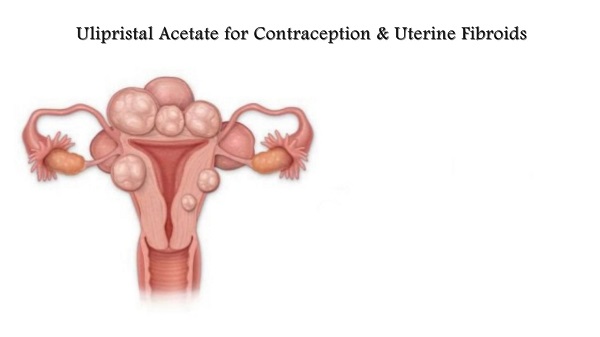
On the other hand, it is considered a first-line contraception pill effective up to 120 hours of having unprotected sexual intercourse. Ulipristal acetate or UPA is the active pharmaceutical ingredient in the pill; this is combined with other components to create the finished products. (1)
Table of Contents
Mechanism of Action of UPA as Emergency Contraception
UPA’s principal mechanism of action delays or inhibits rupture of follicles. It is one of the proactive female contraception methods only when administered in the follicular phase, i.e. before the luteinizing hormone takes its peak during ovulation time.
This emergency hormonal contraception is effective on the function of sperm and post-ovulatory events in preventing pregnancy. It also impairs the interaction of embryo-uterine action, although not gamete functions. (2)
Mechanism of Action of UPA on Fibroids
UPA being a selective progesterone level receptor modulator or SPRM has created a new platform for medicinal science to treat large size fibroids.
SPRM is a synthetic compound that acts as an antagonist on the target tissues by binding with progesterone receptors.
UPA binds with uterine fibroids, endometrium, and pituitary gland to elicit the action through modulation of some specific markers, which regulates respective cell functions. (3)
It helps in shrinking the size of the fibroid with a combined effect of:
- Proliferation inhibition
- Apoptosis of transitory stimulation
- Extracellular matrix (4)
All these three components link to form a higher matrix metalloproteinase-2 (MMP-2) level of expression. This regulates the shrinking effect of fibroid and the associated heavy menstrual bleeding.
What are Fibroids?
One of the most frequently asked questions on the internet is what are fibroids? It is a type of tumour found in the reproductive system of a woman. It is mostly non-cancerous. It is made of fibrous connective tissues and smooth muscle cells.
It is medically stated that 77% of women have uterine fibroids. However, only one third of those women get large fibroids, which need to be treated. It is not a sign of ovarian cancer neither is it an influencing factor. It generally fades away with the menopause or post-menopausal stage, when reproductive hormone gets reduced in the body of a woman. (5)
In some cases, uterine leiomyomata or fibroid takes the form of a benign tumour. It causes neoplasm of the uterus causing cancerous growth among 2% to 3% of women.
Types of Fibroid
- Intramural fibroids – Growth in between muscles of the uterine wall
- Fibroid in submucosal level – Bulges into the uterine cavity
- Fibroid in subserosal level – The growth that projects out of the uterus
What is the Cause of Fibroid?
Fibroid is a health condition when aberrantly structured cells formed on the uterine wall grow under the influence of estrogen and progestin.
There is no stated medical reason responsible for the growth of the fibroid. However, some common factors responsible can be:
- Genetic factor – Heredity has a higher risk of developing fibroid.
- Extracellular matrix (ECM) – ECM is a material making the cells stick together. E.g. mortar used in between bricks for making a construction. Under influence of hormones, its innate growth factor arises and causes some biological changes. This increases ECM in fibroid making them fibrous and influences growth.
- Obesity – It has a greater impact on menstrual health and associated problems.
- Early menstruation – The onset of the menstrual cycle at an early age is a responsible factor.
- Vitamin D deficiency – Deficiency of Vitamin D makes an impact on female reproductive hormone regulation and uterine condition.
- Other factors – A diet low on green vegetables, fruits, and dairy products higher the risk of fibroid. (6) Also Read- Herbal Remedies for Severe Menstrual Cramps
How is Fibroid Formed?
During every menstrual cycle, the uterus lining prepares itself for implanting the fertilized ovum. Under the potency of oestrogen and progesterone, the wall thickens itself. This appears to augment the growth of tissues that later on forms cluster as fibroids. These specific tissues have additional receptors of oestrogen and progesterone.
A set of medical practitioners and researchers believe that steam cells present in smooth muscular tissues in the myometrium of the uterus develop fibroids. Long-term treatment or pregnancy shrinks the fibroid or in some cases the fibroid disappears as it makes the uterus go back to its normal size. (7)
Health Conditions Associated with Fibroids
- Anaemia
- Primary dysmenorrhea or cramping pain in the lower abdomen
- Painful bowel
- Constipation
- Heavy menstrual flow
Symptoms of Fibroids
- Periods lasting for more than one week
- Heavy blood flow during periods
- Pelvic pressure or pain
- Frequent sensation of urination or difficulty in emptying the bladder
- Back and thigh pain
- Constipation
- Spotting in between two periods
- Painful intercourse
Source of Ulipristal
Anzen Exports is a trader and exporter of active pharmaceutical ingredients (API), herbal extracts, and nutraceutical extracts. One of our top selling products is Ulipristal. We source these APIs from leading manufacturers of India and export those to national and international companies making the drugs. We have been serving this industry for the last 30 years. Our product quality and service efficacy is our strength and identity.
Blogs are our endeavour to reach out to the readers with information related to ailments, precautions, and cure. Send us your feedback and share the blog to reach maximum readers.
Disclaimer:
Anzen Exports’ blog posts are based just on our research from cited websites. To be best informed, we advise consulting a doctor about an ingredient or medicine prior to taking it.
Sources:
- NCBI
Website – https://www.ncbi.nlm.nih.gov/pmc/articles/PMC5155051/#:~:text=Ulipristal%20acetate%20is%20a%20progesterone,approved%20as%20a%20postcoital%20contraceptive.&text=As%20progesterone%20promotes%20the%20growth,receptor%20may%20reduce%20their%20size. - Reproduction fertility
Website – https://rep.bioscientifica.com/view/journals/rep/159/3/REP-19-0355.xml#:~:text=in%20several%20countries.-,Its%20principal%20mechanism%20of%20action%20involves%20inhibition%20or%20delay%20of,exerts%20contraceptive%20effects%20besides%20ovulation. - RBM Online
Website – https://www.rbmojournal.com/article/S1472-6483(18)30190-1/pdf#:~:text=UPA%20reduces%20fibroid%20size%20by,et%20al.%2C%202015). - Oxford Academic
Website – https://academic.oup.com/biolreprod/article/97/3/337/4096253 - Pandia Health
Website – https://www.pandiahealth.com/resources/understanding-fibroids-and-birth-control/ - Mayo Clinic
Website – https://www.mayoclinic.org/diseases-conditions/uterine-fibroids/symptoms-causes/syc-20354288#:~:text=Hormones.,normal%20uterine%20muscle%20cells%20do. - Mayo Clinic
Website – https://www.mayoclinic.org/diseases-conditions/uterine-fibroids/symptoms-causes/syc-20354288#:~:text=Hormones.,normal%20uterine%20muscle%20cells%20do.
